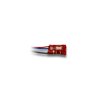Product Support for: Function Decoders -> Single DCC Function Decoder with Integrated Transponding (TL1)
View the Product Page for the TL1TL1 Single DCC Function Decoder with Integrated Transponder
11 Articles Found for TL1
1. Before using your TL1, set its address. This may or may not be the same address as a mobile decoder already installed in the loco or car depending on how you are planning to use the TL1. In the case of TL1s being used as a stand alone transponder or as a function decoder, choose an address that is not associated with another mobile decoder address in use on the layout.2. Connect the RED & BLACK wires of the TL1 to a service mode DCC programmer and program the TL1's address as you would any mobile decoder address.Follow the ...
Q: Can I use non-Digitrax decoders on a Transponding layout?A: Yes. If you want to add transponding to a decoder that does not have the feature, add TL1 or TF4 to the decoder. Some non-Digitrax decoders that use supersonic features are not compatible with transponding unless you switch off the supersonic feature. Digitrax supersonic decoders are compatible with transponding and can be used in supersonic mode while transponding.
Q: Can I use Transponding with existing Digitrax decoder installations?A: Once transponder receivers are installed on the layout, you can run any transponder equipped locomotive. All current production Digitrax decoders are transponder equipped. Older Digitrax decoders models without transponders and decoders made by manufacturers that don't support transponding can add transponding by installing a TL1 or TF4 to the locomotive.
Q: Which decoders work on Transponding layouts?A:All DCC decoders can be used on transponding layouts. However, only those decoders with Transponding capabilities turned on will issue a report each time they enter or exit a Transponding Zone. All current production Digitrax decoders include transponding.Transponding can be added to any decoder by installing a TL1 or TF4.
Will I be able to use Transponding with other DCC systems?Yes. You will have to run LocoNet, instrument your layout and install TL1 or TF4 or transponding decoders in your locomotives. You can then use a computer on LocoNet to display position and ID information for transponder equipped locos. LocoNet will run independently of your existing non-LocoNet system.
You can simply add a TL1 or TF4 to locos with decoders made by other DCC manufacturers. In the case of some supersonic decoders made by other DCC companies that are not transponding compatible, you will need to turn off the supersonic feature when you want to use transponding. Digitrax supersonic decoders are compatible with transponding and can be used in supersonic mode while transponding.
Once you have instrumented your layout for transponding, you simply add transponder equipped locomotives and you are ready to go. Digitrax decoders have been shipped with transponding included since 1999. All current production Digitrax decoders are transponder equipped. Older Digitrax decoders models without transponders and decoders made by other manufacturers can add this capability by installing a transponder such as the TL1 or TF4 to existing DCC locomotive installations. These transponders also add functions to the loco.
1. Install BDL16 series occupancy detector(s). BDL16, BDL162 and BDL168 occupancy detectors can be used together on the same layout.2. Add RX4 transponder receivers to the zones you want to set up for transponding. (You won't need to cover every detection section on the railroad for effective coverage and reporting. Some areas will be detection only sections while others will have full transponding as needed.) Use either two RX4s with your BDL168 to set up 8 transponding zones or use one RX4 if you only need 4 transponding zones.3. All current production Digitrax decoders are transponder equipped. If you have decoders ...
Here are some terms that you might find useful as you work with the BDL168. Direct home wiring is a layout wiring method where each power district and its booster is electrically isolated. The track within each power district uses a "common return" wiring method for occupancy detection and/or power management. Direct home wiring is the wiring method recommended by Digitrax for safety reasons & also because it makes detection work more prototypically. Power district is the power wiring, track, components and equipment attached to that wiring, driven by a single properly isolated booster. The track for a power district ...
OpSw Setup Enter OpSw mode by pressing the OpSw button. The OPS and ID light will flash alternating RED and GREEN. Use your throttle in SWITCH mode to set switches to thrown or closed to match your desired OpSw setting. There are currently no published OpSws for the BXPA1. If you erroneously set an OpSw, the BXPA1 can be factory reset by setting OpSw40 = Closed Trip Speed Pot The Trip Speed Pot can be adjusted to set the speed at which auto reversing and power management is resolved. Turning the pot clockwise will make the speed slower and turning ...
Digitrax decoders have outputs that can control lamps and other on/off devices installed in your locomotive. These are called functions. Functions are things like: lamps, sound units, smoke units, etc. All Digitrax decoders are equipped with two or more function outputs that are used to turn functions on and off.Decoder function outputs can be:1. Leads (wires) attached to the decoder that are used to hook up external functions. See Table I below for wire color codes used on Digitrax decoders.or2. Pre-wired function outputs that hook up by just plugging in the decoder. This is the case for decoders that ...
